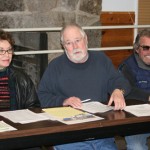Jesus Serrano and Pamela Arellano, guitarists
As advertised throughout the Idyllwild community, the expected return of guitarist Jesus Serrano took place on a brilliant Sunday afternoon in William M. Lowman Concert Hall under the auspices of the formal liaison and amanuensis to the performer; this occasion being supplemented by another guitarist under David Pelham's guidance, Zacatecas' own Pamela Arellano.
The difficulties of last year's scheduling — including problems with the artist's visa as well as the fire season's aftereffects — were fortunately avoided. Arellano's parents were also part of the nearly full auditorium's complement and all were afforded a fully specified traversal of 19th- and 20th-century instrumental music for solo and duo guitars.
In advertising the upcoming concert, the bill was promoted as "The Art of the Guitar in Mexico," a somewhat misleading trope. Though both performers are Mexican-born, only one of the program's selections featured a Mexican composer's work — most of the other pieces were musical pictures of Spain, Brasil, Argentina and Venezuela — something pointed out by Pelham in advance.
Following that introduction, Arellano essayed the Mexican composer Gerardo Tamez's three-part suite "Aires de Son" with a chiefly classical approach, as was the case with Argentine composer Maximo Diego Pujol's "Suite del Plata No. 1." Both works emphasize a clearly neo-Baroque influence, though based on dance movements (especially the Pujol 5-part work). Arellano did her part to bring forth the essential sound and rhythm required. Her playing was inspired by a deep understanding of natural guitar tone and fretting positions. This was confirmed by her interpretations of the Villa-Lobos arpeggio study and the Tárrega "Capricho Árabe," where the approach meant maximum attention to the actual sound and not entirely dependent on flashy effects (which in those aforementioned pieces, should be kept to a minimum).
In her final solo outing — the tragically short-lived Tunisian/Parisian guitarist/composer Roland Dyens' arrangement of the Vinicius de Moraes (Antonio Carlos Jobim's "A Felicidade") — she proved that the samba tune should be predominant, whatever the tempo or volume.
A short intermission followed before Serrano's appearance. To this listener, this proved a necessary hiatus before the cascading notes of Dyens' composition "Fuoco" broke forth from Serrano's instrument — thus focusing his talent on the more complex of modern sounds that a guitar and guitarist is capable of.
He stepped backward in time to concentrate on Francisco Tárrega's "Gran Jota," which involved a really virtuoso turnabout from sound production to alternating dance rhythms. A further retreat from the initial piece was provided by Venezuelan composer Aureo Puerta Carreño's "Canción para ti," another neo-Baroque "invention" (in the J.S. Bach sense) demanding a lyrical approach to the main theme and an alternating effectuation of the remainder, again without "flash."
Serrano's next offerings reflected on his partnership with the concert's interlocutor. The two pieces of David Pelham ("Brown and Blue" and "Ashes and Tears") are worthy of a second hearing — particularly the latter with its evocation of a fire's aftermath (as a contrast to the Dyens’ piece).
The American guitarist/composer Kevin Callahan's "Red Fantasy" provided a return to a less sedate configuration of sound with the basis of the argument in the effects of six varieties of red wine, and in the following two Villa-Lobos guitar studies, Serrano stated his main proposal that sound proves meaning, regardless of technical prowess.
The afternoon was concluded by the two principals combining in a three-part duet composition of Maximo Diego Pujol (once again) — and both made easy work of the dance movements' intricacies — and in the finale broke into a full-fledged fiesta (which to this listener, was the main point of the concert as a whole). The more than appreciative audience gave forth enthusiastic bravos and plaudits, and many were encouraged to attend the small reception following where further congratulatory accolades were bestowed on both an accomplished pupil and an acknowledged master of the acoustic guitar.










